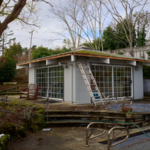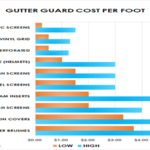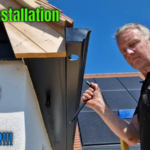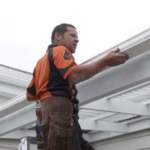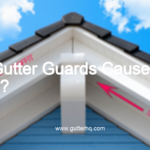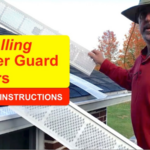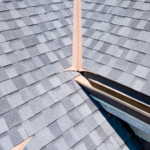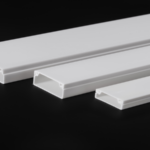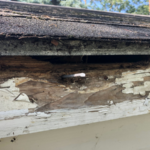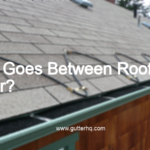There are a few places that roofs commonly leak: around the chimney, skylights, and vents; at the valleys where two roof planes come together; and at the eaves—the edges of the roof that overhang the walls.
What is the most common cause of roof leaks?
The most common cause of roof leaks is improper installation or maintenance. If your roof is not installed correctly, it is more likely to leak. Additionally, if you do not maintain your roof properly, it is more likely to develop leaks.
How can you tell where your roof is leaking?
If your ceiling is discolored or has water spots, it may be time to check your roof for leaks. Inspect your attic for any signs of water damage, such as mold or mildew. If you see any of these signs, it’s important to have a professional roofer take a look as soon as possible.
Another way to tell if your roof is leaking is by checking the gutters. If you see any granules from your shingles in the gutters, that’s a good indication that your roof is starting to fail. It’s also a good idea to have a roofer inspect your gutters to make sure they’re properly installed and functioning properly.
Finally, if you notice any leaks in your home, make sure to have a roofer come out and take a look. Leaks can cause serious damage to your home, so it’s important to have them fixed as soon as possible.
What is the weakest part of a roof?
The weakest part of a roof is typically the point where the roof meets the wall or chimney. The reason for this is that the roof is constantly being pushed up by the weight of the house and the wind. The weakest part of the roof is also the point where the most precipitation and sunlight hits the roof, which can cause the material to degrade over time.
What part of the roof prevents leaks?
The roof is the first line of defense against the elements, and one of the most important parts of the roof is the flashing. Flashing is a strip of material (usually metal) that is installed around vulnerable areas of the roof, such as the valleys (where two roof planes meet) and the chimney. The flashing prevents water from seeping into the home through these vulnerable areas.
Do homeowners insurance cover roof leaks?
Homeowners insurance typically does not cover roof leaks, as they are typically considered to be maintenance issues. However, if the leak was caused by a covered event, such as a tree falling on the roof, then it would likely be covered.
Is it normal for roof to leak in heavy rain?
It is normal for roofs to leak during heavy rain. The water pressure on the roof can cause the shingles to loosen and allow water to seep through. If you have a leaky roof, you should have it repaired as soon as possible to prevent further damage.
How long should a roof last before it leaks?
It is difficult to determine how long a roof will last before it leaks because it depends on many factors, such as the quality of the materials used, the climate, and the maintenance. However, most roofs should last at least 15-20 years before needing repairs due to leaks. If a roof begins to leak sooner than this, it is likely due to poor installation or materials.
While a roof can last many years, it is important to keep an eye out for signs that it may be leaking. If you notice any water spots on your ceiling, it is important to have a professional inspect your roof as soon as possible. Leaks can cause significant damage to your home, so it is important to address them quickly.
If you are concerned about your roof leaking, there are a few things you can do to prevent it. Make sure your gutters are clean and in good repair, as they can help direct water away from your roof. You should also have your roof inspected regularly to catch any potential problems before they cause leaks.
Will a leaking roof collapse?
It is unlikely that a leaking roof will collapse, but it is possible if the leaks are left unaddressed for an extended period of time and the structure of the roof is significantly weakened as a result. If you suspect your roof is leaking, it is important to have it inspected by a professional as soon as possible to determine the extent of the damage and make any necessary repairs to prevent further deterioration.
Why is my ceiling leaking when it rains?
There are a few possible reasons for your ceiling leaking when it rains. One possibility is that your gutters are not properly draining water away from your home. This can cause water to build up and eventually leak into your home through the roof. Another possibility is that there is a crack or hole in your roof that is allowing water to seep through. If you have a leaky roof, it is important to have it repaired as soon as possible to avoid further damage to your home.
How do I fix a leaking roof permanently?
- The first step is to identify the source of the leak. This can be done by visually inspecting the roof or by hiring a professional to conduct an inspection.
- Once the source of the leak has been identified, it is important to make any necessary repairs to the roof. This may include repairing or replacing damaged shingles, sealing any gaps or cracks, or applying a waterproof sealant to the roof.
- Once the repairs have been made, it is important to regularly inspect the roof for any new leaks. This can be done by hiring a professional roofing contractor or by conducting regular inspections yourself.
- If you find any new leaks, it is important to make the necessary repairs as soon as possible. By taking these steps, you can help to ensure that your roof lasts for many years to come.
Last Word
There is no definitive answer to this question as every roof is different and will have different areas that are more prone to leaking. However, some common areas to check for leaks are around skylights, chimneys, vents, and any other openings in the roof. It’s also important to check for any cracked or missing shingles, as these can also lead to leaks. If you’re not sure where to start, it’s always a good idea to have a professional roofer come and take a look.

